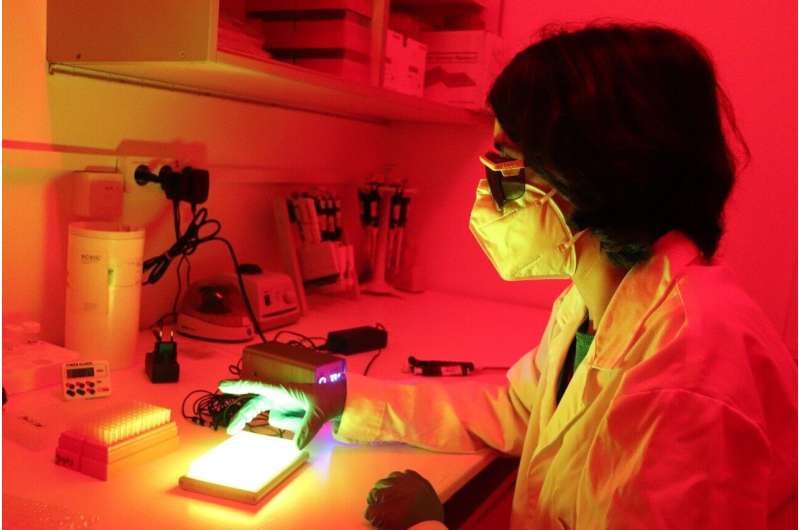This article has been reviewed according to Science X's editorial process and policies. Editors have highlighted the following attributes while ensuring the content's credibility:
fact-checked
peer-reviewed publication
proofread
Researchers develop light-controlled drugs for future precision therapies against diseases such as cancer

Researchers from the Institute for Advanced Chemistry of Catalonia (IQAC) of Spanish National Research Council (CSIC) have developed a series of photosensitive molecule drugs that can be reversibly activated by external light, thus achieving a much more localized and controlled biological effect. This research, published in the Journal of Medicinal Chemistry, suggests that photopharmacology (drugs controlled by light) paves the path for highly specific therapies that could open new avenues for the treatment of diseases such as cancer.
One limitation of cancer drugs is that they often fail to fully differentiate between cancer cells and healthy cells. This lack of selectivity of current chemotherapy limits its therapeutic window, which decreases the effectiveness of the treatment and causes unwanted side effects.
"Photosensitive drugs, whose activity can be precisely controlled with external light in a reversible manner, can solve this problem, since they provide a great control of the site of action and for a desired time, thus decreasing the side effects and increasing their efficacy," explains Laia Josa Culleré, researcher from the Medicinal Chemistry and Synthesis group of IQAC, and lead author of this study.
New advances towards light-controlled drugs
The use of light is especially attractive in this research of new targeted anti-tumor drugs, since it allows a control of the anti-tumor activity by adjusting parameters such as wavelength, intensity, and exposure time.
Thus, the photosensitive molecules change their structure when illuminated under particular light conditions, so that an effect on specific target receptors can be induced under light control. This may allow external control of the therapeutic effect of the drug with greater precision.
"To date, this type of drugs is in the experimental phase for applications in the retina or pain, but so far there are not many studies with good results in oncology," explains Laia Josa Culleré.
This study focused on a common target in oncology, histone deacetylase (HDAC) enzymes. When these enzymes are dysregulated, they prevent the expression of certain genes, such as tumor suppressors, and therefore in these circumstances, the cells are more likely to become cancer cells. For this reason, multiple drugs are being developed aimed at inhibiting poorly regulated HDACs in order to slow the progression of this disease.
Currently, there are conventional drugs that act on these enzymes, but these have a low selectivity and toxic effects. For this reason, this research focused on designing molecules based on these conventional drugs, but that could be reversibly regulated by light, allowing their activity to be controlled by changing illumination conditions.
The first results showed that when these molecules were activated by light, they inhibited HDACs as opposed to when they were inactive in the dark. The limitation of these early molecules is that they required ultraviolet light to be activated, which can be harmful to cells, and has low penetration in biological tissues. Therefore, the molecules were optimized to be activated with green light (visible light), and also obtained better results under illumination than in the dark.
Finally, the activity of these molecules was verified in four cancer cell lines: cervix, breast, leukemia and colon. The results showed an increase in cancer cell death after illumination with green light, but had no effect when kept in the dark. "One of the strengths of the study is that these molecules are activated with visible light (green), whereas almost all the molecules that are described against cancer are activated with ultraviolet light, which prevents the approach from progressing to in vivo tests and in patients," explains Amadeu Llebaria from the Medicinal Chemistry and Synthesis group of IQAC.
Objective: More specific and controlled therapies
As a result of the study, the researchers have developed a small library of photosensitive molecule drugs that allow control of cell viability only through illumination with visible light, which is more permeable and less damaging to cells. It is believed that these results will pave the path to feasible study of the effect of these molecules in vivo, in zebrafish or in mice, via selectively illuminating the tumor area to activate the drug, while maintaining it in the rest of the body in its inactive form, thus avoiding unwanted side effects on healthy tissues.
"We believe that the study of these photosensitive molecules is important to establish an in vivo proof of concept on the use of photopharmacology to treat cancer more effectively and safely," concludes Josa Culleré.
More information: Laia Josa-Culleré et al, Visible-Light-Controlled Histone Deacetylase Inhibitors for Targeted Cancer Therapy, Journal of Medicinal Chemistry (2023). DOI: 10.1021/acs.jmedchem.2c01713
Journal information: Journal of Medicinal Chemistry
Provided by Spanish National Research Council (CSIC)



















